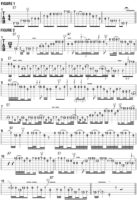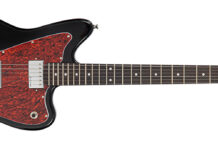
Expanding Blues-Scale Licks with the Major Third
In our previous two lessons, we investigated a variety of ways in which to include the major third as an additional note within the structure of the E blues scale (E G A Bb B D), as a means to broaden our scope for melodic soloing.
We began by doing this in second/third position, then moved up to fifth position. This month, we’ll ascend to seventh position, and I’ll present a 12-bar slow blues solo using this fretboard pattern.
To review, the blues scale is intervallically spelled 1 b3 4 b5 5 b7. The major third of E is G#, and adding this note to the E blues scale results in the note sequence E G G# A Bb B D, which gives us the interval spelling 1 b3 3 4 b5 5 b7. A chromatic row now exists between the minor third, G, and the fifth, B: G G# A Bb B.
FIGURE 1 illustrates the E blues scale plus the major third played in seventh position, both ascending and descending. On the way up, I sound the major third, G#, by bending the minor, or “flatted,” third, G, up a half step. In the second octave, and also in the descending form, I fret the G# normally, as an unbent note. Keep in mind that you can convey the sound of the major third using either approach, and bending strings is an essential expressive technique when playing a blues solo, so try using both approaches.
FIGURE 2 presents an original 12-bar blues solo in E, played over a slow 12/8 (triplet-feel) groove and restricted to seventh position. Confining yourself to a single position like this across an entire 12-bar solo forces you to choose your notes and craft your phrases more carefully than if you give yourself free rein over the entire fretboard.
The great benefit of doing this, however, is that it effectively breaks the habit of letting your fingers dominate your note choice, meaning that it will force you away from unconsciously playing the same habitual licks and patterns and think more melodically.
While playing through this solo, strive to maintain the same finger/fret assignments throughout, in order to derive the greatest gain from this exercise. The index finger frets all notes at the seventh fret, the middle finger frets the notes at the eighth fret, the ring finger frets the ninth fret and the pinkie frets the 10th fret. There are, of course, a few exceptions depending on a specific phrase, such as when bending, but in general this is a good approach to take.
I begin the solo with a bend from the minor third, G, to the major third, G#, and then work my way over to the high E string via various licks and phrases. Some of the rhythmic syncopations are complex, so be sure to focus on each beat individually as you construct the longer solo lines.
Source: www.guitarworld.com








